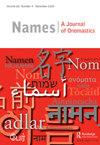利用ANPS类型学揭示日本手语的地名分布与地域认同的关系
IF 0.6
3区 文学
0 LANGUAGE & LINGUISTICS
引用次数: 0
摘要
本研究通过Blair&Tent(2020)澳大利亚国家地名调查(ANPS)类型学对184个日本手语地名进行分类,考察了日本手语地名的分布。收集国家手语地名地图(日本聋人联合会等,2009年)中的地名,并按类别分类到电子表格中,电子表格中保存了标记计数。地形类别分布表明,近畿地区与日本的民族认同有着密切的历史联系,与纪念同名相关的标志数量不成比例。过去对手语地名的研究表明,社会和结构因素对地名的传播和产生具有重要影响。本研究通过揭示区域身份指数的结合如何支持特定类型地名的保存,有助于理解地名的病因。本文章由计算机程序翻译,如有差异,请以英文原文为准。
Using the ANPS Typology to Unearth the Relationship Between Japanese Sign Language (JSL) Endonymic Toponym Distribution and Regional Identity
This study examines Japanese Sign Language (JSL) toponym distribution by categorizing 184 JSL endonymic toponyms via the Blair & Tent (2020) Australian National Placename Survey (ANPS) typology. Toponyms from the National Sign Language Toponym Map (Japan Federation of the Deaf et al. 2009) were collected and sorted by categories into a spreadsheet, which maintained token counts. Topographical category distribution shows that the Kinki region, which has a strong historical connection to Japan's national identity, has a disproportionately large number of signs related to commemorative eponyms. Past work on sign language toponyms has demonstrated the salience of social and structural factors on toponym spread and production. This study contributes to the understanding of toponym etiology by revealing how the incorporation of regional identity indices might support the preservation of particular kinds of toponyms.
求助全文
通过发布文献求助,成功后即可免费获取论文全文。
去求助
来源期刊

Names-A Journal of Onomastics
Multiple-
CiteScore
1.30
自引率
50.00%
发文量
23
期刊介绍:
Names, the journal of the American Name Society, is one of the world"s leading journals in the study of onomastics. Since the first issue in 1952, this quarterly journal has published hundreds of articles, reviews, and notes, seeking to find out what really is in a name, and to investigate cultural insights, settlement history, and linguistic characteristics revealed in names. Individuals subscribing to Names automatically become members of the American Name Society and receive the journal as part of their membership.
 求助内容:
求助内容: 应助结果提醒方式:
应助结果提醒方式:


